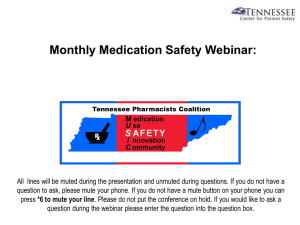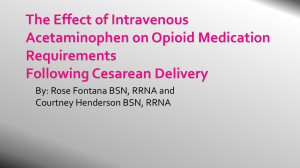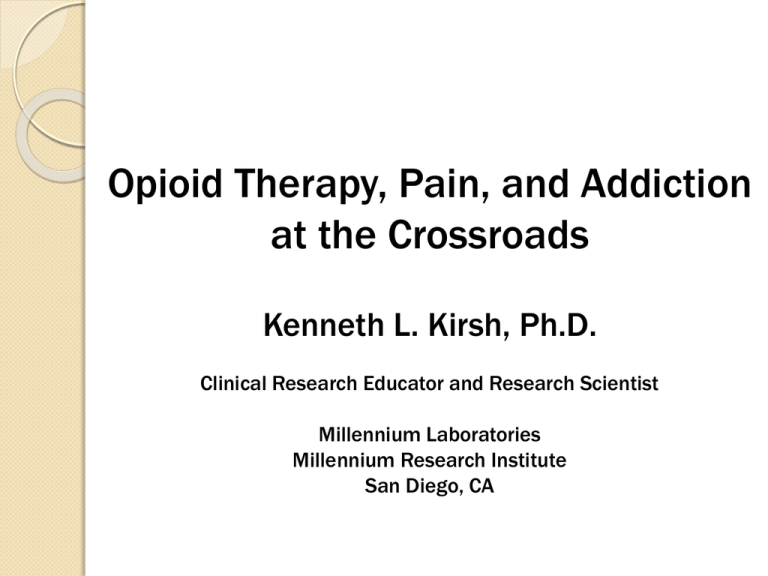
Opioid Therapy, Pain, and Addiction
at the Crossroads
Kenneth L. Kirsh, Ph.D.
Clinical Research Educator and Research Scientist
Millennium Laboratories
Millennium Research Institute
San Diego, CA
The Opioid Pendulum
Opiophobia
Opiophilia
Balance of Addiction
Medicine and Pain
Management
Principles1
1Gourlay, D.L.
et al. Universal precautions in pain medicine: A rational approach to the treatment of chronic pain. Pain Medicine. 2005;
6(2): 107-112.
Nearly 20 years of expanded opioid
prescribing: What have we learned?
• Something fundamental about the clinical
use of opioids?
OR
• Something fundamental about what our
healthcare system is bad at?
What is our healthcare system bad at?
• Chronicity
• Conditions with major
motivational/psychiatric
component
• Communication among
professionals
• Ongoing risk assessment
• Conditions that intersect badly
with SES
• Stigmatization
Goldney RD, et al. Depression, diabetes, and quality of life: A population study. Diabetes Care. 2004; 27(5): 10661070.
Patrick DL, et al. Symptom management in cancer pain: Pain, depression, and fatigue. Journal of the National Cancer
Institute. 2003; 95(15): 1110-1117.
Winkleby MA, et al. Social class disparities in risk factors for disease: Eight-year prevalence patterns by level of
education. Preventative Medicine. 1990; 19: 1-12.
Two Commonly Used
Classes of Medications
PPIs
Opioids
Yoshikawa I, et al. Long-term treatment with proton pump inhibitor is associated with undesired weight
gain. World J Gastroenterol. 2009; 15(38): 4794-4798.
Pushing the Pendulum Towards Opiophilia
• Trivialization of risk and
overstatement of benefits
o To individual patients
o To society
• Pain management is easy,
just follow the numbers
• Pain patients vs. addicts
• The delivery system will
deliver us
Base Rates of Addiction/Abuse:
Vulnerabilities in the Population
8.7% Illicit Drugs
6.2% Alcohol
26.5% Nicotine
SAMHSA, Results from the 2011National Survey on Drug Use and Health: Summary of National Findings. NSDUH Series H-44, HHS
Publication No. (SMA) 12-4713. Rockville, MD: Substance Abuse and Mental Health Services Administration, 2012.
Pseudo-addiction?
Weissman & Haddox
Passik, Kirsh, & Webster
• N of 1 case study
• Failures to demonstrate it
empirically
• Inpatient
• Became surly and
uncooperative
• Pain management
improved, behavior
improved
• Use of illegal drugs covered?
• Overuse of prescribed
medications by outpatients
covered?
• Primary vs. secondary
alcoholism as a better model
Weissman DE, Haddox JD. Opioid pseudoaddiction – an iatrogenic syndrome. Pain. 1989; 36(3): 363-366.
Passik S, et al. Pseudoaddiction revisited: A commentary on clinical and historical considerations. Pain Management, 2011;
AIDS Patients and Aberrant Behaviors
Adequate
Analgesia
(n=49)
Inadequate
Analgesia
(n=24)
Total # of aberrant
behaviors
Aberrant behaviors
“probably less predictive
of addiction
305
(6.2)
239
(78%)
152
(6.3)
116
(74%)
Aberrant behaviors
“probably more predictive
of addiction
66
(22%)
40
(26%)
Passik SD, et al. Pain and aberrant drug-related behaviors in medically ill patients with and without histories of substance abuse. Clinical
Journal of Pain. 2006; 22(2): 173-181.
Percent Using in Past Month
Non-Medical Use of Psychotherapeutic
SAMHSA. Results From the 2007 National Survey on Drug Use and Health. DHHS Publication No. SMA 06-4194, 2006. Obtained from
http://www.samhsa.gov/data/nsduh/2k7nsduh/2k7Results.htm
Numbers in Thousands
New Illicit Drug Use
in the United States: 2002
2500
2000
1500
1000
500
Inhalants
Sedatives
Heroin
Stimulants
Marijuana
Pain
LSD
Cocaine
Ecstasy
Tranquilizers
Relievers
SAMHSA. Results From the 2002 National Survey on Drug Use and Health. DHHS Publication No. SMA 06-4194, 2006.
Obtained from Obtained from http://www.samhsa.gov/data/nhsda/2k2nsduh/results/2k2Results.htm#toc.
PCP
Doctors on Trial:
Pain Docs or Drug Dealers?
Satterfield J. Pain clinic owner standing trial on charges she traded pills for cash. Knoxnews. September 25, 2012: Retrieved from
http://www.knoxnews.com/news/2012/sep/25/pain-clinic-owner-standing-trial-on-charges-she/
What Makes News?
• Sex
&
• Drugs
&
• Rock and Roll
This?
14
Or This?
What Constitutes Functional Improvement,
Anyway?
Improvement?
Slowing the rate
of decline?
Pushing the Pendulum Toward Opiophobia
• Opioid strawman
• Addiction is
resident in drugs
• Hyperalgesia
The Opioid Strawman
Where does Addiction Live?
Addiction is not Simply
a Disease of Exposure
Burroughs:
Exposure
Current
Exposure is necessary not
sufficient
• Exposure to drug
• Vulnerable person
• Vulnerable time
Burroughs W. Junkie. New York, NY: Ace Books; 1973.
Does Drug Selection Matter?
Long-acting Opioids vs. Short Acting Opioids
Fentanyl Patch
Fentanyl TIRF
Setnik B, et al. The abuse potential of remoxy, an extended-release formulation of oxycodone, compared
with immediate-release and extended-release oxycodone. Pain Medicine. 2011; 12(4): 618-631
Hyperalgesia
Easy to demonstrate in:
o Rats1
o Humans on opioids in acute pain
o Chronic pain???2
Undeniable that some people are better off, off opioids
Is this
o Hyperalgesia?
o Hypogonadism?
o Psychological/Existential distress?
o Having normal bowel movements?
1Tassorrelli
C, et al. Nitroglycerin induces hyperalgesia in rats: A time course study. European Journal of Pharmacology. 2003;
464(2-3): 159-162.
2Fishbain
829-839.
DA, et al. Do opioids induce hyperalgesia in humans? An evidence-based structured review. Pain Medicine. 2009; 10(5):
Risk Management is a Package Deal
Screening and risk stratification
Use of PMP data
Compliance Monitoring
o Urine screening
o Pill/Patch counts
Education regarding drug storage
and sharing
Psychotherapy and highly “structured” approaches
Abuse-deterrent formulations
Passik SD, Kirsh KL. The interface between pain and drug abuse and the evolution of strategies to optimize pain management
while minimizing drug abuse. Experimental and Clinical Psychopharmacology. 2008; 16(5): 400-404.
Population of Rx Opioid Users
Is Heterogeneous
Nonmedical
Users
Pain Patients
Passik SD, Kirsh KL. The interface between pain and drug abuse and the evolution of strategies to optimize pain management
while minimizing drug abuse. Experimental and Clinical Psychopharmacology. 2008; 16(5): 400-404.
Assessment of Addiction Risk
Measures for screening for addiction risk
o
o
o
o
STAR/SISAP1
CAGE AID2
Opioid Risk Tool (Emerging Solutions in Pain)3
SOAPP (see painedu.org)4
Psychiatric interview assessment of risk
o Chemical
o Psychiatric
o Social/Familial
o Genetic
o Spiritual
Friedman R, Mehrotra D. Treating pain patients at risk: Evaluation of a screening tool in opioid-treated pain patients with and without addiction.
1
Pain Medicine. 2003; 4(2): 182-185
2Brown
RL, Rounds LA. Conjoint screening questionnaires for alcohol and other drug abuse: Criterion validity in a primary care practice. Wisconsin
Medical Journal. 1995; 94(3): 135-140 (retrieved from http://www.integration.samhsa.gov/images/res/CAGEAID.pdf on February 18, 2013).
3Webster
LR. Predicting aberrant behaviors in opioid treated patients: Preliminary validation of the opioid risk tool. Pain Medicine. 2005; 6(6): 432-
442.
4Akbik
H, et al. Validation and Clinical Application of the Screener and Opioid Assessment for Patients with Pain (SOAPP). Journal of Pain and
Symptom Management. 2006; 32(3): 287-293.
How do Different Risk Measures
Compare?
A recent study at a pain practice in Tennessee
o
o
o
A retrospective study of discharged patients
N=48
Risk rating of each patient with all four measures:
o Clinical semi-structured interview by a psychologist
o DIRE (Belgrade et al, 2006)
o ORT (Webster & Webster, 2005)
o SOAPP (Butler et al, 2004)
“Medium” or “High” risk rating = Accurate
prediction
This measure assesses sensitivity (not
specificity).
Moore TM, et al. A comparison of common screening methods for predicting aberrant drug-related behavior among patients
receiving opioids for chronic pain management. Pain Medicine. 2009; 10(8): 1426-1433.
Accuracy in Predicting Discharge
(Aberrant Drug-Related Behaviors)
Measure
% Accuracy Rate
Interview
77%
SOAPP
73%
ORT
45%
DIRE
17%
Moore TM, et al. A comparison of common screening methods for predicting aberrant drug-related behavior among patients receiving
opioids for chronic pain management. Pain Medicine. 2009; 10(8): 1426-1433.
The Growth of
Prescription Monitoring Programs
2003
• 14 states had
monitoring programs
• 36 states had no
prescription monitoring
programs
Data collected from http://www.pmpalliance.org/content/data
2012
• 41 states had
prescription drug
monitoring programs
• 9 states had no
monitoring program
Aberrant Behaviors Versus
Urine Toxicology Testing
Urine
Toxicology
Aberrant Behaviors
Yes
No
Total
Positive
10(8%)
26 (21%)
36 (29%)
Negative
17 (14%)
69 (57%)
86 (71%)
Total
27 (22%)
95 (78%)
122
53/122 (43%) of patients had “problems”
(positive urine screen or behavioral issues)
Katz N, Fancuillo GJ. Role of urine toxicology testing in management of chronic opioid therapy. Clinical Journal of Pain. 2002; 18(4):
S76-S82.
Unexpected UDT Results
Chronic Opioid Therapy
2.6%
Normal
17.6%
14.5%
10.2%
55%
Missing opioid
Additional drug
Illicit substance
Adulterated
Michna E, Jamison RN, Pham LD, et al. Urine toxicology screening among chronic pain patients on opioid therapy: frequency and
predictability of abnormal findings. Clin J Pain 2007; 23: 173-179.
Teaching about
Medication Storage and Sharing
Sharing prescription
meds seen as safe
by “self-treaters”
Need to educate patients
about medication storage
New devices being developed
to help only the patient have
access and on a schedule
programmed by the MD or RN
http://www.lockyourmeds.org/meducation/
Opioid Renewal Clinic
Procedure
• Consult from PCP
• Eligibility
o Workup & pain dx
o Opioid Treatment
Agreement
o Baseline urine drug
test
• PCP CONTINUES TO BE
RESPONSIBLE TO
PRESCRIBE OPIOIDS
Strategy
• Opioid Treatment Agreement
o Second change agreement
• Frequent visits
• Prescribed opioids on shortterm basis
o ie, weekly or bi-weekly
• Random UDT
• Pill counts
• Co-management with
additional services
Wiedemer NL, et al. The opioid renewal clinic: A primary care, managed approach to opioid therapy in
chronic pain patients at risk for substance abuse. Pain Medicine. 2007; 8(7): 573-584.
Opioid Renewal Clinic
(n=171)
Referred for Consistently
addiction
negative
treatment
urines 4%
13%
Aberrant
behavior
Selfresolved
discharged
45%
Aberrant
behavior = 171
No aberrant
behavior = 164
38%
Wiedemer NL, et al. The opioid renewal clinic: A primary care, managed approach to opioid therapy in
chronic pain patients at risk for substance abuse. Pain Medicine. 2007; 8(7): 573-584.
NIDA Study: Adherence Therapy
for Opioid Abusing Pain Patients
40 pain patients at 2 sites in Virginia & New York
o
o
Substance abuse co-morbidity
o
Opioid abuse dependence, >2 on “problems with pain
meds”, no current substance dependence, & lifetime
dependence or current abuse permissible
Psychiatric co-morbidity
o
Evidence of opioid efficacy for diagnosis
>6 mo duration, constant, moderate-severe intensity (VAS
>7 despite daily opioids)
No unstable major psychiatric disorders, current
suicidal/homicidal ideation, or medication dose
considerations
Medical co-morbidity
o
No unstable/severe medical conditions or planned surgery
within study period; no meds that interact with methadone
Haller D, Acosta MC. Characteristics of pain patients with opioid-use disorder. Psychosomatics. 2010; 51:
257-266.
NIDA Study: Adherence Therapy for Opioid
Abusing Pain Patients
10
VAS rating
8
6
4
8.5
9
7.6
7.2
7.1
4.8
2
0
Worst Typical Least
Pain severity
Haller D, Acosta MC. Characteristics of pain patients with opioid-use disorder. Psychosomatics. 2010; 51: 257-266.
7.9
8.4
Differential Diagnosis:
Aberrant Drug-Taking Attitudes & Behavior
Addiction
o Compton1
o Fleming2
Pseudo-addiction
o Elander3
1Compton
P, et al. Screening for addiction in patients with chronic pain and ‘problematic’ substance use: Evaluation of a pilot assessment
tool. Journal of Pain and Symptom Management. 1998; 16(6): 355-363.
2Fleming
3Elander
MF, et al. Substance use disorders in a primary care sample receiving daily opioid therapy. The Journal of Pain. 2007; 8(7): 573-582.
J, et al. Understanding the causes of problematic pain management in sickle cell disease: evidence that pseudoaddiction plays a
more important role than genuine analgesic dependence. Journal of Pain and Symptom Management. 2004; 27(2): 156-169.
Differential Diagnosis:
Aberrant Drug-Taking Attitudes & Behavior
Other psychiatric diagnosis
o
o
o
o
Organic mental syndrome
Personality disorder
Chemical coping
Depression/anxiety/situational stressors
o Wasan1
Criminal intent
o
o
Katz2
Jung & Reidenberg3
1Wasan
AD, et al. Psychiatric history and psychological adjustment as risk factors for aberrant drug-related behavior among patients with
chronic pain. Clinical Journal of Pain. 2007; 23(4): 307-315.
2Katz,
N. et al. (2010). Usefulness of prescription monitoring programs for surveillance—analysis of Schedule II opioid prescription data in
Massachusetts, 1996–2006. Pharmacoepidemiology and Drug Safety, 19(2), 115-123.
3Jung
B, Reidenberg MM. Physicians being deceived. Pain Medicine. 2007; 8(5): 433-437.
We Are All Stakeholders
Patients
Professionals
Law enforcement
Media
3rd Party Payors
Passik SD, Heit H, Kirsh KL. Reality and responsibility: A commentary on the treatment of pain and suffering in a drug-using society.
Journal of Opioid Management. 2006; 2(3): 123-127.
3rd Party Payors
• Frequent visits
• Urine screens
• Psychological care
• Abuse deterrent opioids
• Less drug per prescription
Joranson DE. Are health-care reimbursement policies a barrier to acute and cancer pain management? Journal of Pain and Symptom
Management. 1994; 9(4): 244-253.
Conclusions


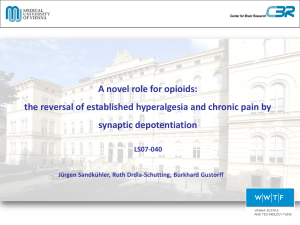
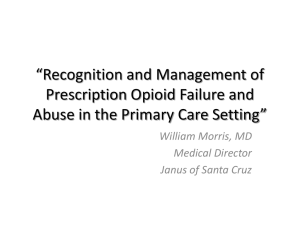
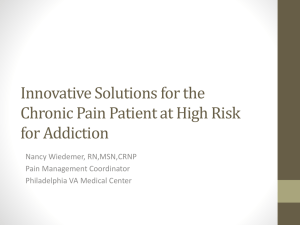
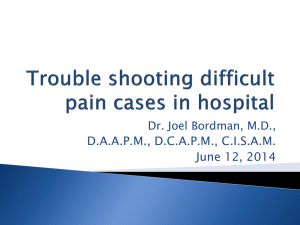
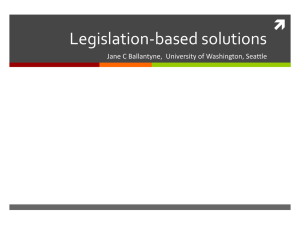
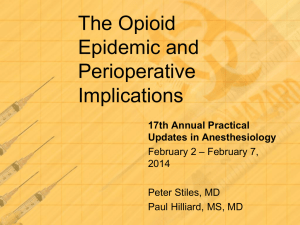
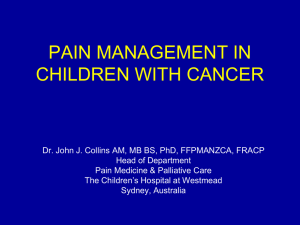

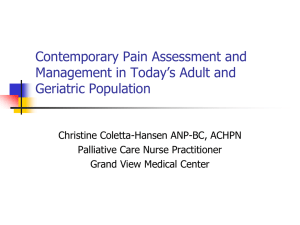

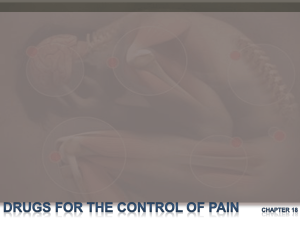

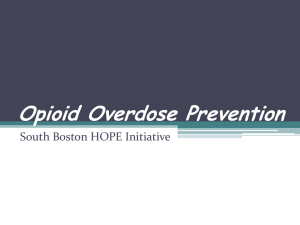
![Slides [PowerPoint]](http://s2.studylib.net/store/data/005600327_1-9e9384bed45e687960e45f966cb28408-300x300.png)

